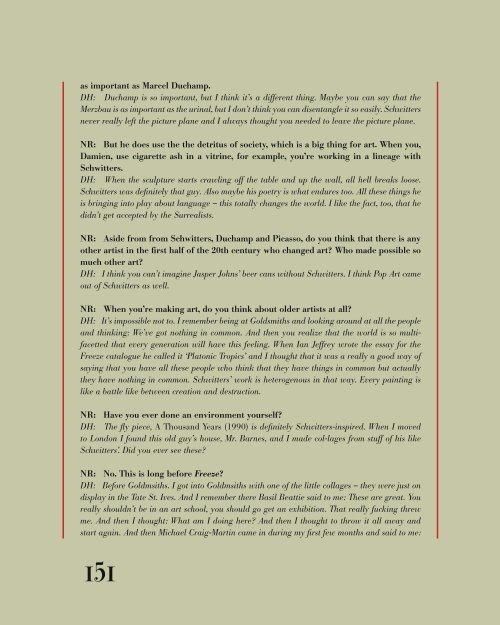Kurt Schwitters: Merz (2016) – Norman Rosenthal interviews Damien Hirst
Fully illustrated catalog published by Galerie Gmurzynska in collaboration with Cabaret Voltaire Zurich on the occasion of Kurt Schwitters: MERZ, a major retrospective exhibition celebrating 100 years of Dada. The exhibition builds and expands on the gallery’s five decade long exhibition history with the artist, featuring exhibition architecture by Zaha Hadid. Edited by Krystyna Gmurzynska and Mathias Rastorfer. First of three planned volumes containing original writings by Kurt Schwitters, historical essays by Ernst Schwitters, Ad Reinhardt and Werner Schmalenbach as well as text contributions by Siegfried Gohr, Adrian Notz, Jonathan Fineberg, Karin Orchard, and Flavin Judd. Foreword by Krystyna Gmurzynska and Mathias Rastorfer. Interview with Damien Hirst conducted by Norman Rosenthal. Includes full color plates and archival photographs. 174 pages, color and b/w illustrations. English. ISBN: 978-3-905792-33-1 The publication includes an Interview with Damien Hirst by Sir Norman Rosenthal about the importance of Kurt Schwitters's practice for Hirst's work.
Fully illustrated catalog published by Galerie Gmurzynska in collaboration with Cabaret Voltaire Zurich on the occasion of Kurt Schwitters: MERZ, a major retrospective exhibition celebrating 100 years of Dada. The exhibition builds and expands on the gallery’s five decade long exhibition history with the artist, featuring exhibition architecture by Zaha Hadid.
Edited by Krystyna Gmurzynska and Mathias Rastorfer.
First of three planned volumes containing original writings by Kurt Schwitters, historical essays by Ernst Schwitters, Ad Reinhardt and Werner Schmalenbach as well as text contributions by Siegfried Gohr, Adrian Notz, Jonathan Fineberg, Karin Orchard, and Flavin Judd.
Foreword by Krystyna Gmurzynska and Mathias Rastorfer.
Interview with Damien Hirst conducted by Norman Rosenthal.
Includes full color plates and archival photographs.
174 pages, color and b/w illustrations.
English.
ISBN:
978-3-905792-33-1
The publication includes an Interview with Damien Hirst by Sir Norman Rosenthal about the importance of Kurt Schwitters's practice for Hirst's work.
Create successful ePaper yourself
Turn your PDF publications into a flip-book with our unique Google optimized e-Paper software.
as important as Marcel Duchamp.<br />
DH: Duchamp is so important, but I think it’s a different thing. Maybe you can say that the<br />
<strong>Merz</strong>bau is as important as the urinal, but I don’t think you can disentangle it so easily. <strong>Schwitters</strong><br />
never really left the picture plane and I always thought you needed to leave the picture plane.<br />
NR: But he does use the the detritus of society, which is a big thing for art. When you,<br />
<strong>Damien</strong>, use cigarette ash in a vitrine, for example, you’re working in a lineage with<br />
<strong>Schwitters</strong>.<br />
DH: When the sculpture starts crawling off the table and up the wall, all hell breaks loose.<br />
<strong>Schwitters</strong> was definitely that guy. Also maybe his poetry is what endures too. All these things he<br />
is bringing into play about language – this totally changes the world. I like the fact, too, that he<br />
didn’t get accepted by the Surrealists.<br />
NR: Aside from from <strong>Schwitters</strong>, Duchamp and Picasso, do you think that there is any<br />
other artist in the first half of the 20th century who changed art? Who made possible so<br />
much other art?<br />
DH: I think you can’t imagine Jasper Johns’ beer cans without <strong>Schwitters</strong>. I think Pop Art came<br />
out of <strong>Schwitters</strong> as well.<br />
NR: When you’re making art, do you think about older artists at all?<br />
DH: It’s impossible not to. I remember being at Goldsmiths and looking around at all the people<br />
and thinking: We’ve got nothing in common. And then you realize that the world is so multifacetted<br />
that every generation will have this feeling. When Ian Jeffrey wrote the essay for the<br />
Freeze catalogue he called it ‘Platonic Tropics’ and I thought that it was a really a good way of<br />
saying that you have all these people who think that they have things in common but actually<br />
they have nothing in common. <strong>Schwitters</strong>’ work is heterogenous in that way. Every painting is<br />
like a battle like between creation and destruction.<br />
NR: Have you ever done an environment yourself?<br />
DH: The fly piece, A Thousand Years (1990) is definitely <strong>Schwitters</strong>-inspired. When I moved<br />
to London I found this old guy’s house, Mr. Barnes, and I made col-lages from stuff of his like<br />
<strong>Schwitters</strong>’. Did you ever see these?<br />
NR: No. This is long before Freeze?<br />
DH: Before Goldmsiths. I got into Goldmsiths with one of the little collages – they were just on<br />
display in the Tate St. Ives. And I remember there Basil Beattie said to me: These are great. You<br />
really shouldn’t be in an art school, you should go get an exhibition. That really fucking threw<br />
me. And then I thought: What am I doing here? And then I thought to throw it all away and<br />
start again. And then Michael Craig-Martin came in during my first few months and said to me:<br />
151

















